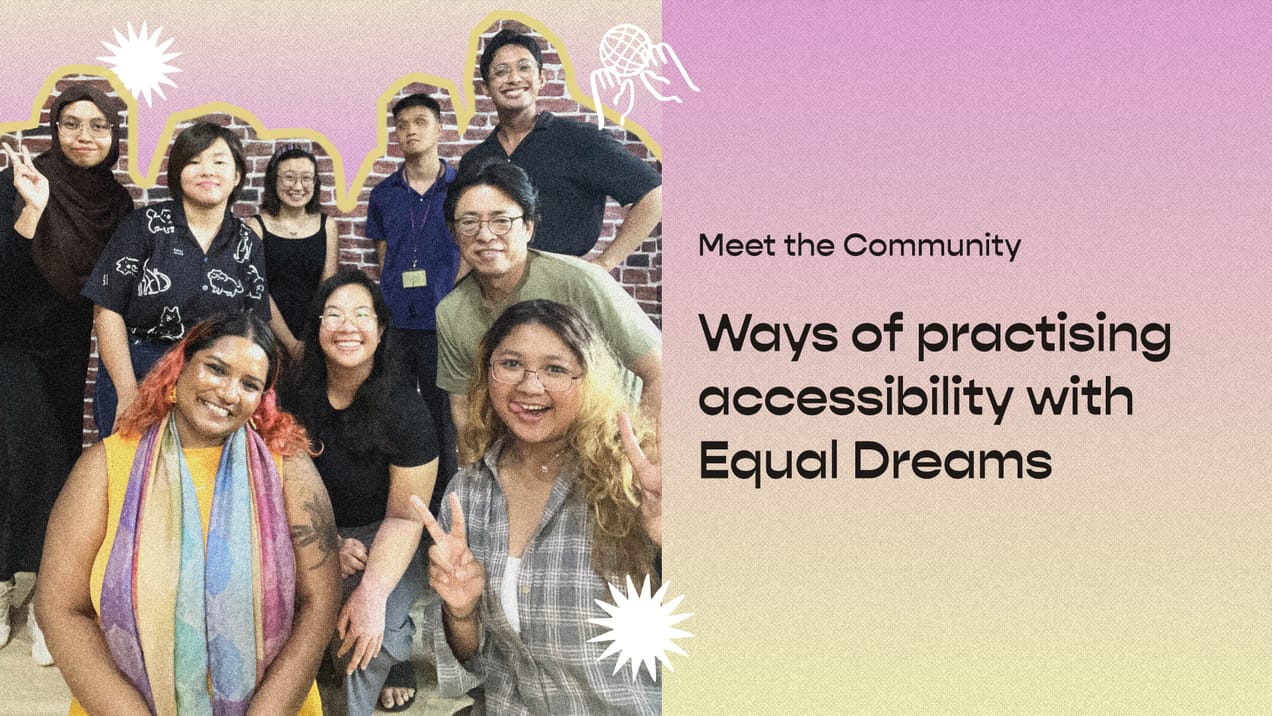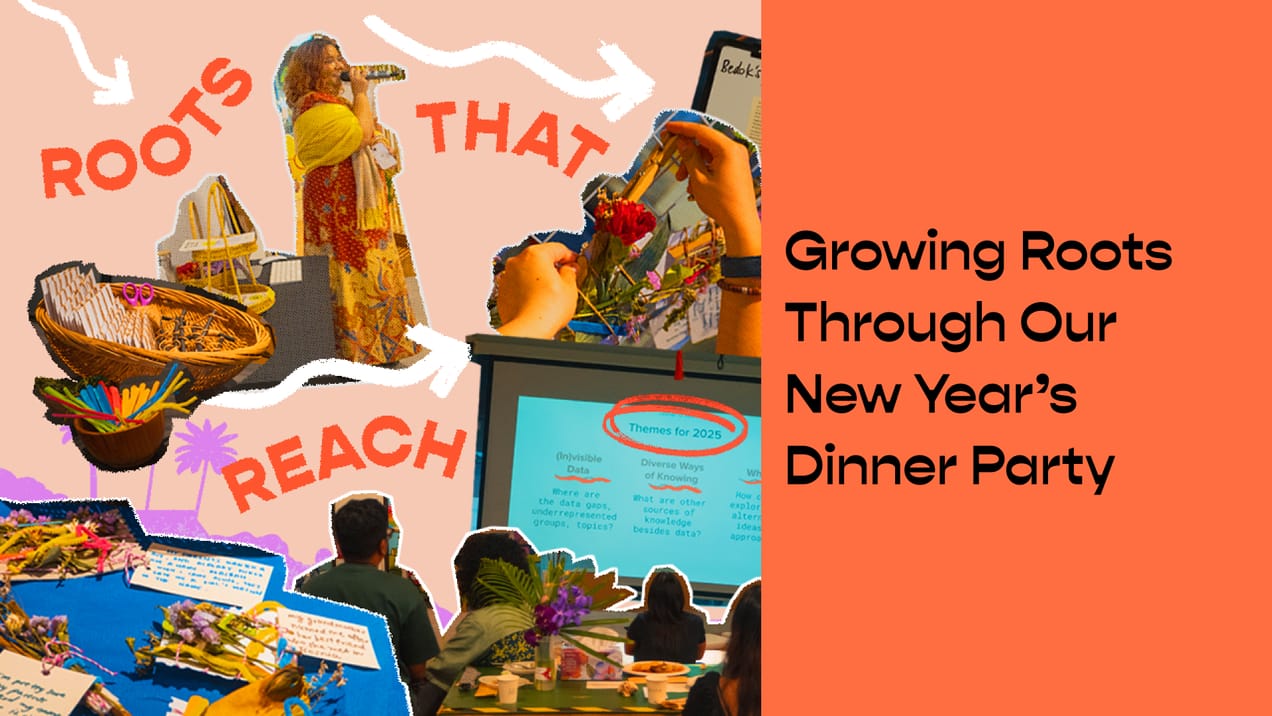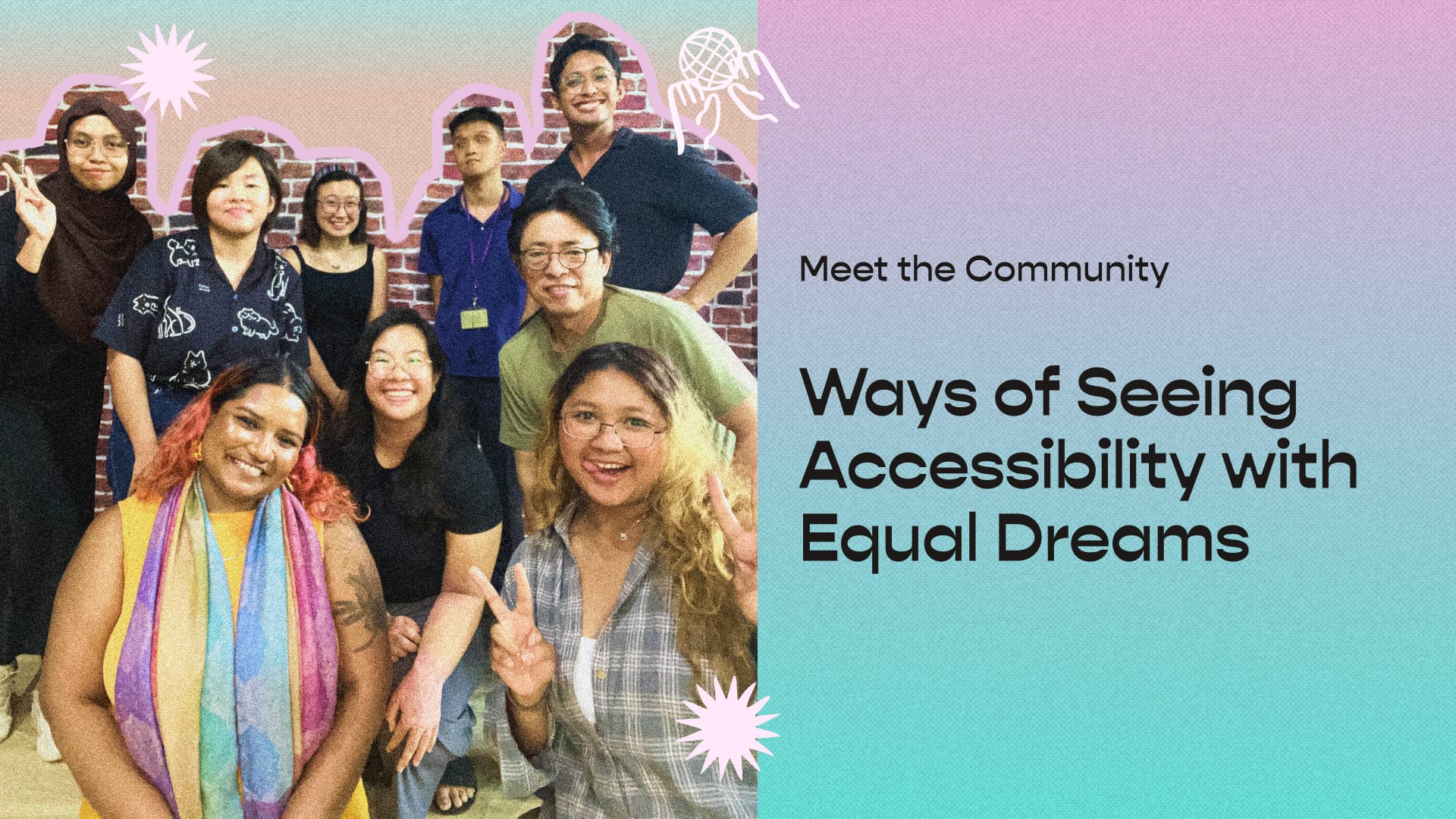
Ways of seeing accessibility with Equal Dreams
Accessibility is becoming an increasingly ubiquitous term used by practitioners in different fields, from researchers to designers to developers. Yet how the term is understood and how it’s practised are constantly being shaped by personal experiences, power dynamics, histories, contexts, and community dynamics. We sat down with Equal Dreams, a social business moving the needle forward when it comes to accessibility, who shared this and more with us. They are approaching accessibility through a more systemic, intersectional lens: from professionalising access services to advocating for access and inclusion to be a default and cemented in the very processes of organisations rather than as an add-on. We were keen to understand their ideas of access, and how they navigate and practise accessibility in their daily lives and work.
We spoke to: Clara Chee, a Team Lead; Hidayat Khalid, a Team Lead; Neo Kah Wee, a Digital Accessibility Specialist; Minjie Tim, an Accessibility Specialist and Training Developer; Faaiqah Alkaff, a Singapore Sign Language (SgSL) Instructor, Deaf Interpreter and Social Media Manager; Andrew Tay, a Singapore Sign Language (SgSL) Specialist and Deaf Interpreter; and Patricia Merilo, the Digital Accessibility Lead.
This interview was conducted both in-person and asynchronously, so team members could respond live or type their answers during and after the session using a shared Google document. Some members of the team also provided Singapore Sign Language interpretation during the session. Image descriptions in this article were worked on collaboratively with the Equal Dreams team.
Note: The interview responses have been lightly edited and condensed for clarity and length.
Accessibility is all-encompassing.
What does access mean and look like for you, whether it’s in your personal life, community, or the work you do?
Kah Wee: Access to me is about breaking the barriers between can and cannot. People have this notion that “Oh, visually handicapped people cannot do this, or they can only do that”. I just hope that through my work here, we can spread awareness, open up more opportunities for others, and make things more accessible, [whether] on the physical or digital side.
Clara: In Singapore, disabilities are often equated with one or two access features, which stops us from integrating inclusion into the entire process. It’s treated as something that can be tagged on at the very end. But it's about building a culture of care and community.
Universal design features like captioning, speech-to-text interpretation, and good image description can end up benefiting more than just a small, intended audience. You might think that captions are only designed for the Deaf and hard of hearing community, but so many more people can benefit from them. I really struggled through school and I couldn't really focus in class. But as an adult, when I went to a conference with live captioning, I realised I could focus [better]. And even when access features are more directly benefitting a smaller group, the act of considering access and creating a culture that is authentically safe and welcoming benefits all of us, disabled or not.
Faaiqah: You know when you watch a movie, and there are captions, everyone ends up enjoying it, right? It makes me feel a little bit angry sometimes because access can benefit everyone. So why can’t this concept of captions that is so easily implemented, not be extended to other spaces?
Clara: Secondly as an access service provider, [what we aim for is] quality access.
In traditional media, sign language interpretation [is typically cast in] a very small box, at the corner of the screen. In this case, access is there. [But] does it truly do justice to the language, the culture, and the community? And how can we actually platform them? You cannot determine that when it's just a group of non- disabled people discussing [access needs]. You have to hear the voices of the community about what quality access can look like for them. We did a few videos such as one done with the National Library Board, where Faaiqah was involved, and we used a side-by-side view of the performance along with a large view of the Deaf interpreter.
Andrew: I have 3 scenarios to share.
First, an event where no sign language interpreter is provided. Perhaps there’s speech-to-text interpreting, or captions.
Second, an event where a sign language interpreter is provided, but they're signing in SEE II (Signing Exact English II), which follows the grammar and syntax of English, like English but on the hands.
For the first and second scenarios, they end up being exhausting. Reading for the entire duration, or seeing the interpreter sign word-for-word following the structure of the English language, both lead to visual fatigue, and are not ideal options for accessibility for me. If you asked me to chat about the event after, I’d stay passive during the conversation, because the content was not fully accessible to begin with.
Third, an event where a sign language interpreter is using Singapore Sign Language (SgSL), and utilises interpretation skills to create a visual, 3D picture. This is the type of access that makes me feel joy. I am able to understand what's happening 100%—and beyond that I'm able to start, contribute and participate in dialogues and conversations after the event, having fully known what went on. That is what it feels like to be truly included.
Andrew: Have you heard of the term “deaf nod”? It happens when some deaf people are nodding along not because they're truly following based on what the interpreter is signing, but because they're tired of having to clarify what the interpreter means over and over.
I had an experience attending (my daughter’s) school event, where the interpreter [missed out] key information and could not follow [what the speaker was saying], perhaps because there were certain terms they weren't sure of. At that moment, I wanted to know what was coming up for my child, what her future was going to look like, but there was that barrier to full information access. Sign language interpreters who aren’t involved in the Deaf community and don't have a good understanding of Deaf culture, tend not to sign very well. If they were to engage more with the community, it would be evident in their interpretation and linguistic skills.
Minjie: We owe a lot to disability history innovation for the things we take for granted, like captioning, or even for example, the fact that MRT [stations] didn't have lifts in the past. Whether we think about it or not—we have benefited from disability history. We have to remember that and it should inform our work. When we engage with disability rights it cannot come from a place where we think of ourselves as the saviour, it has to come from a place of solidarity because we have already benefited from this movement.
Accessibility is creative collaboration.
Accessibility is often just framed as a gap to fill. Were there times where you found creative, unexpected ways to make things more accessible?
Faaiqah: When I was in school, I was doing lighting design for a production. As a Deaf person, I was a bit worried about communication on stage because spoken dialogue is [what is] typically used during a production. So what we did was to use sticky notepads. When they tell me to stand by, the stage manager will point at the notes. It's just a small thing right? But it made me feel really happy and joyful because it becomes a collaborative process which I am included in.
Kah Wee: When I was in Polytechnic, I was not able to view the white board as a visually handicapped person. The lecturers were aware that I was considered partially blind, so they actually got the final-year students to design glasses that can project the screen onto the glasses. Even though I tried them and they didn't really work, I thought it was quite a nice and innovative thing to do. They even used their own resources to make it.
Clara: If you look at movies with audio description, the movie content and the audio description are typically separate. One of the projects I really enjoyed working on was with the National Gallery Singapore (NGS), where we did an integrated audio description approach. We worked with a blind gallery visitor and had her tell the story of how she was experiencing the museum, so that the audio description was coming from a user's perspective.
Having different access needs in [our own] team has its own barriers to navigate, but it also teaches you so much more about what a welcoming and inclusive space can look like. One important thing we have learned is that access is not one person's but a shared responsibility. This means everyone being considerate, and doing things like describing what's on the screen and learning some sign language. Because if we don't share the same language, how will we communicate?
Faaiqah and Kah Wee even have their own method of communicating.
Kah Wee: Faaiqah showed me that you can use a text-to-speech approach to communicate. Now when I communicate with her, I type on my phone and show it to her. And when she wants to talk to me, she types using the text-to-speech feature. There was one time in the office when it was just the two of us, and there was no interpreter. We were able to communicate and go to lunch together—it was quite interesting. Before I joined Equal Dreams, I came from a school for students with disabilities and though there were deaf students there, I never imagined that I could actually communicate with them without an interpreter.
Faaiqah: I get what you mean, Kah Wee. Back then I would have never ever thought that I would be able to communicate with a blind person either. When I started my internship in the organisation, there was a blind person who was communicating with me through sign language and I was like, “Ehh, wow!” (surprised)
It was something new for me to figure out. It's just that she can't see my signs so I was a bit stressed and wondering how we could make this happen. So I used Google Translate’s read-aloud feature.
I think opening up that space for patience and understanding between each other created that process where everyone contributes towards accessibility for the team. Often in larger organisations, you might have one DEI (Diversity, Equity, and Inclusion) person, or a very small team who works on access.
That might be a structure that works for a lot of organisations, but everyone should also be thinking about access.
Kah Wee: Each of us has our own needs and capabilities, so we can play to our strengths that help meet the access for everyone. For example, I can't see so when I went to eat lunch with Faaiqah, she’s my eyes or if she ever needs help in communicating, then I can help.
Faaiqah: Then you're my voice lah.
Kah Wee: Yeah, we focus on the ability rather than the disability.
Accessibility is care
How do you hold space for each other's different access needs, energy levels or boundaries, especially when things get busy?
Faaiqah: I remember [when I first joined Equal Dreams], Clara gave me a list of guidelines so I don't have to keep asking people for things. For me that's care.
Andrew: I teach SgSL classes. Once a student approached Hidayat saying they were facing some learning challenges in the class. Hidayat suggested providing regular breaks in between the lessons, and to let the student go last when asking them to respond in sign to give them more processing time to respond confidently. If they are not able to respond, that's okay too.
Hidayat: The student actually approached their coordinator Minjie, and the team came together to discuss what accommodations would look like in a way that was equitable to other students in the class. It wasn’t just about providing accommodations, but really considering the experience and whether it worked or not while also discussing options and checking in with the students themselves. It's important to include the people who require accommodations in that conversation.
We actually got quite excited to be able to discuss such a practice of care. It was quite a good learning process for us. In terms of the team, we are all very caring (laughs).
We [also] understand that when it gets quiet [during meetings], everyone is processing. Or when there are certain things that require deeper interpretation, the interpreters [might need to take] more time to explain. Silence during meetings are actually important for more effective discussions and communication.
Minjie: I remember when I first joined, we were in our other office where we [usually] work around a common table. I thought my colleagues were not talking much because I couldn't hear anything. Later I realised it was because everyone was signing, and it just works out for me [because] I often need my own quiet corner to concentrate. I really appreciate the moments where we sit together in silence, like when we take a break or go out for lunch after a rather intense meeting.
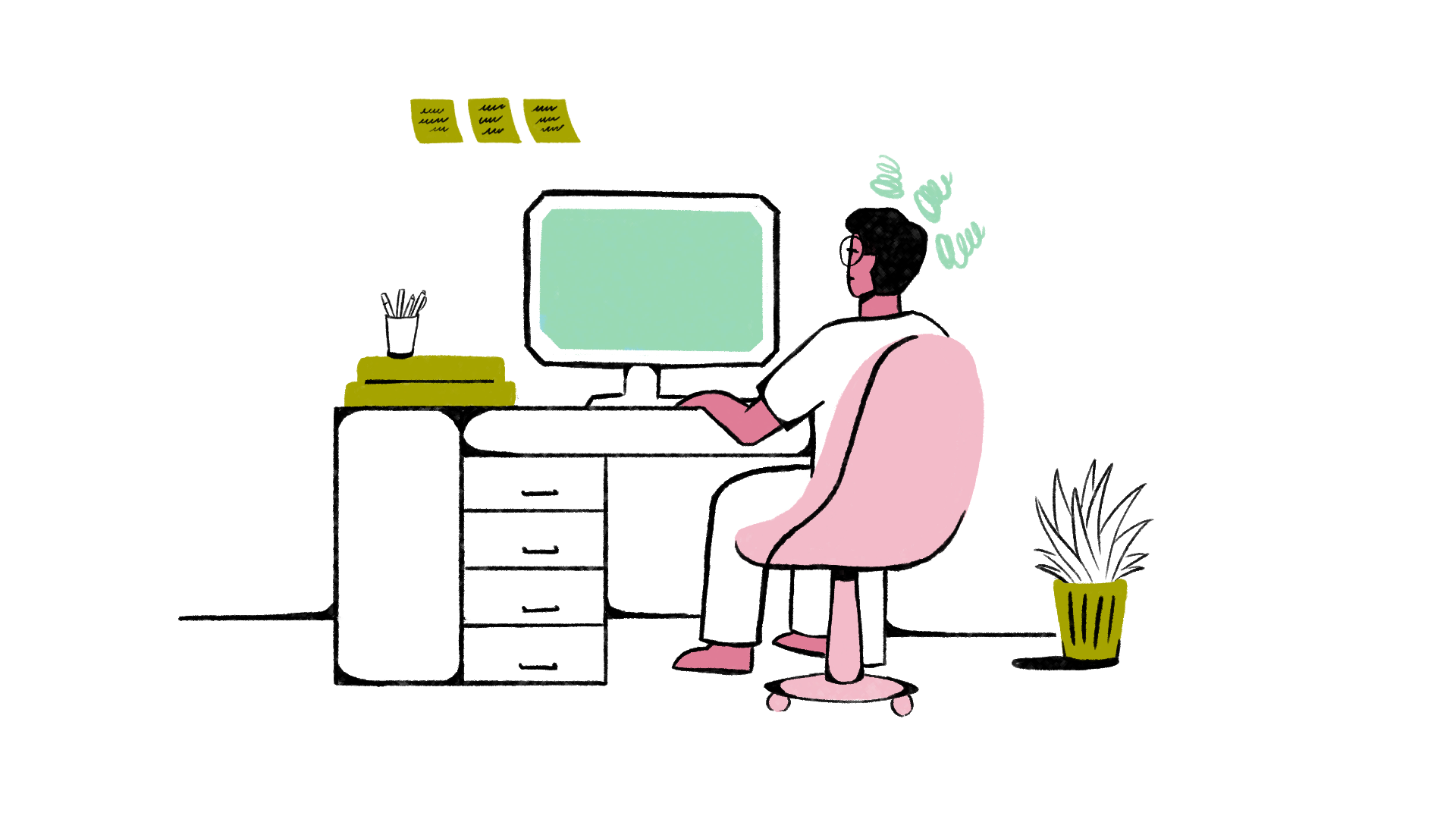
There is also a lot of openness from everyone towards other people’s approach to working. There are no particular norms of behaving or communicating. I feel very comfortable taking a table and putting it in front of a wall at a random time of the day, just because I need to face the wall to concentrate. When I am in a hyperfocus state, they just know not to talk to me. I think it comes from a culture where there is trust and everybody has a level of self-awareness as well, and that helps everyone in doing what they need to do.
Kah Wee: I am a very noisy person, so sometimes I struggle to keep quiet. I think the team shows care in the sense [that] they know I really need to talk, so even though they want to be silent they will let me chat at the table.
I also try to show care—if I know someone needs personal space, I’ll try to limit how much I talk. I think I’ve started to get used to it. When I first joined, I wasn’t used to the space being so quiet. Sometimes I hear people laughing and I’d be like, “Huh?” because I didn’t know what was going on—but slowly I realised it was because they were signing.
That’s how people show care here—not only by being silent, but also by being loud.
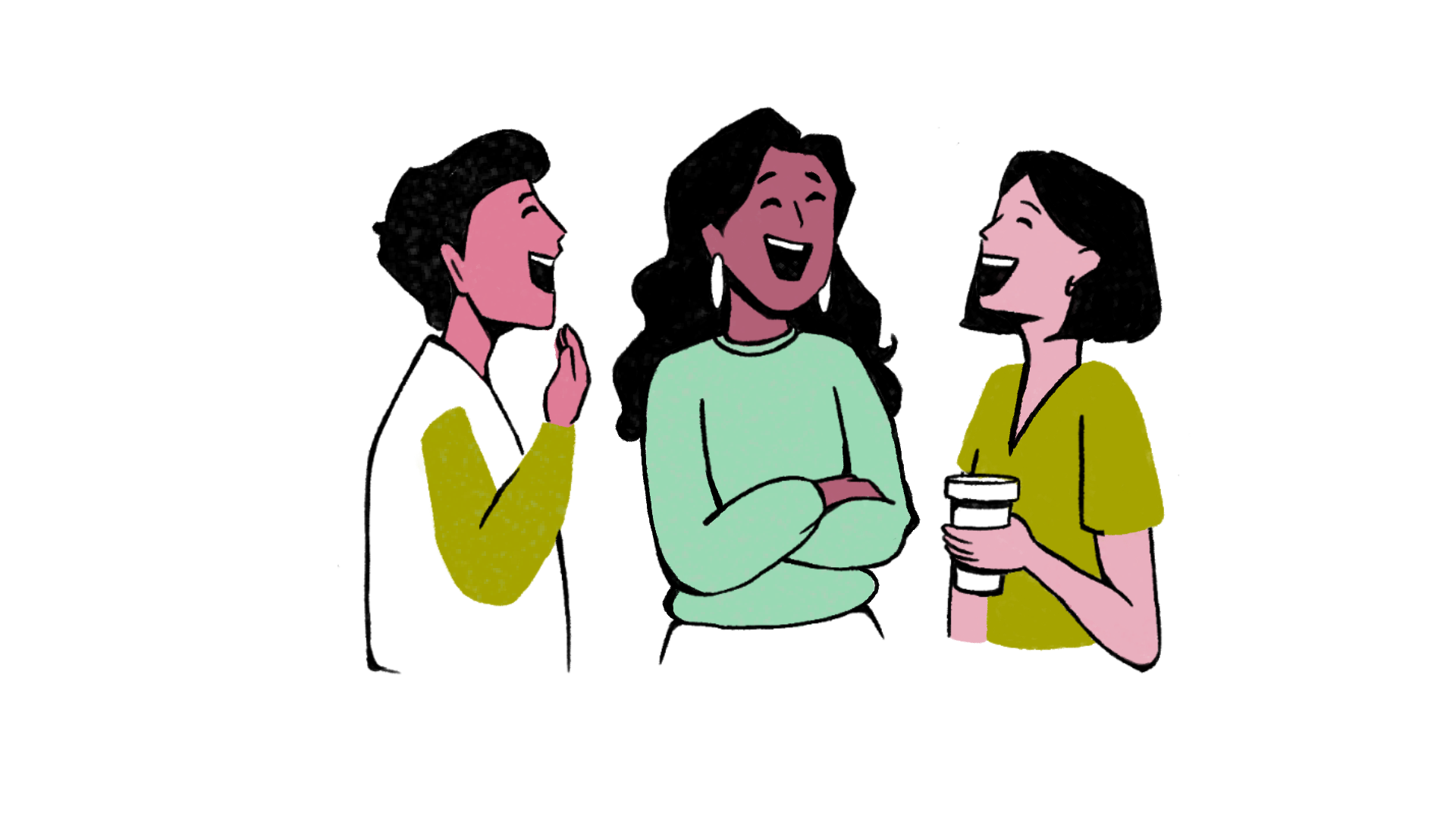
Accessibility is people-first
What are some moments at Equal Dreams where accessibility felt like care to you?
Clara: Coming from a very corporate environment prior to joining Equal Dreams, I [thought that] growing up in Singapore and its education system meant that everything must be fast and efficient. But in Equal Dreams I am unlearning a lot of that. Sometimes it’s not about having the discussion quickly, but giving everyone time to process it. It's also what you can do outside that discussion, like preparing an agenda or letting people type in their ideas in advance.
Also being gentle with each other and having a lot of trust within the team. If someone asked to postpone a meeting because they are not up to it today, they will make up for it. When I think about [care in] this team, I don't think about work processes. It's just so integrated. To me care is to consider each other [first], and then the work.
Pat: It’s [about] checking in on one another—not just about work, but how we’re really doing. If we find the workload too much, we will always find ways to work around it as a team. We try to normalise flexibility whether that’s stepping away from the screen, taking a silent break or needing more time to process during meetings, or shifting timelines when someone needs rest. We also hold space for different communication styles, and access needs, and we’re constantly learning to adapt.
Clara: I actually got my ADHD diagnosis a year into joining Equal Dreams. I remember prior to that I was struggling with admin work, the kind that Faaiqah is doing now, on a day-to-day basis. It was just sending out certificates, but it still took the whole day for me to do, and even then it was full of errors. So when I finally got my diagnosis, prompted by those issues, I told our Director that actually I have ADHD. And her first reply was, “Oh I am so happy that you found out about it. Let me know what else we can do to change things at work, so you can do your best work”. That conversation made me realise that access needs should be part of work culture already. Nobody thinks of you as different just because you need something. It’s never like, “Because you don’t work the same way as everyone else, then you’re less”.
When I told the team, their reaction was just “Oh, OK”. To me, that’s the best response you can get. There was no negative response, it's just part of everyday life.
Accessibility is boundless
If the world had been built with care and accessibility from the very beginning, how would you imagine it to look and feel like?
Kah Wee: I would imagine it to be a world where care is a norm. We don't have to remind people to do it, almost like breathing. Nobody reminds you to breathe, right? So I think that one day if the world can become like that, it'll be very nice lah.
Sometimes, some organisations will specify that we cater for this or that disability, and I wonder, “why do you have to advertise that? If it's the norm, why do you have to emphasise it all the time?” These are just my own thoughts lah. But sometimes I do feel that by emphasising, you are already treating it as a special thing. It's not something I want to see in the long-run.
Faaiqah: A world where access is provided [even if] there are no obvious users. It's not something that you have to request for. In my ideal world accessibility is available 24/7 by default. I can dream, right? (Laughs)
Andrew: It’s so exhausting to keep asking. [In an] ideal world, deaf people are all over, where everyone is signing happily and can use sign language to communicate.
Faaiqah: When they look at me, I don't want them to see me as that Deaf person, I want them to see me as Faaiqah.
Back when I was in [my first year] of Polytechnic, none of the students knew anything about accessibility. When there was an interpreter in the classroom, they all looked at the interpreter instead of [communicating directly with] me. But as time went on, I felt their gaze shift towards me. [Initially] I would be the one reminding the teacher to switch on the captions, [later it was] my classmates who were [doing the reminding]. My classmates were shown what access looks like, they learnt what it meant, and started taking that initiative to consider access.
In a new place, you still have to do a lot of educating about access and what it means. But just like my Polytechnic friends, over time people learn and change their behaviour and attitude from having someone like me in the classroom. I feel like [change is] definitely possible. It's just that people don't have that exposure, they have never seen access before.
I also wish that there was more awareness and consideration. Once I remember I was walking and there was a cyclist who was shouting behind me. How would I know that you’re there?
Pat: If the world had been built with care and accessibility from the start, I think it would feel a lot more easeful. There’d be less explaining, less apologising, less fighting to be included. Access wouldn’t be something you have to ask for, it would be already there. Ramps, captions, sign language, quiet spaces, flexible work setups, all these wouldn't be called special arrangements, they’d just be.
It would be a world where difference is expected, rest is respected, voices are heard, and no one is made to feel like they’re being “too much” or “not enough” for the space they are in.
Minjie: The image that comes to me is a forest. Disability is a human spectrum. Right now, society has labeled certain behaviours as disabled and others as not. This distinction is not very useful, because it stops us from having a better understanding of our needs. So the ideal world I imagine would look like a forest, because there is so much diversity in how everyone is being and thinking and feeling and communicating. There is openness and curiosity to explore that whole range of diversity—like the forest, like ecology.
Clara: Maybe a world with 100% access will never exist because of just how diverse people and access needs are. But I think the promise to handle access with care and consideration, to have an equal conversation where your access needs will be fully heard, where you will have autonomy over these decisions—is what an ideal world looks like.
Stay tuned for Part 2, where the Equal Dreams team shares their vision for a more accessible world, shedding light on the state of disability rights in different contexts and how to prepare for a future where disability can be seen as an inevitability.
We’d like to thank Equal Dreams for being part of this interview, and for supporting us with valuable insights on how to plan and facilitate an inclusive interview process, ensuring that every member had the opportunity to contribute meaningfully. We’d like to acknowledge the team members who provided sign language interpretation during the session, which enriched the discussion by making space for different modes of communication, and thank them for their care and labour in making the space more accessible and inclusive.
Equal Dreams was founded in 2020 in the height of COVID, where they started off with providing accessibility services for the deaf and hard-of-hearing as there was a gap in such accessibility services. Currently, Equal Dreams also provides training programmes on disability awareness and accessibility, and consultancy, while also expanding to work with different communities, such as the blind and low vision community, and the neurodivergent community. Interested to learn more about disability accessibility from Equal Dreams? Check out their recently launched Equal Dreams Academy!
More information about the Equal Dreams team:
Clara (she/her) is a Team Lead at Equal Dreams, developing core programmes, providing accessibility services and overseeing content strategy. Her journey into access began with learning Singapore Sign Language in school and later being diagnosed with ADHD.
Hidayat is a Team Lead at Equal Dreams, overseeing programme development and working as an accessibility specialist providing sign language and speech-to-text interpretation. His background in linguistics sparked his interest in Deaf culture, language, and community.
Kah Wee is a Digital Accessibility Specialist at Equal Dreams, providing feedback on websites and digital platforms. Initially a client, he was introduced to accessibility as a profession through the organisation. Being visually impaired, he draws on lived experience to advocate for inclusive digital spaces.
Minjie (she/her) is an Accessibility Specialist and Training Developer providing accessibility services such as Speech-to-Text Interpretation and developing and training core programs. With a background in social justice, she focuses on integrating an intersectional and systemic lens towards disability and accessibility work.
Faaiqah (she/her) is a Singapore Sign Language (SgSL) Instructor, Deaf Interpreter and Social Media Manager. An artist passionate about accessibility, she aims to integrate access into her theatre practice and broaden her work to include diverse disability communities.
Andrew joined Equal Dreams to develop the Singapore Sign Language (SgSL) curriculum, driven by his passion for accessibility and Deaf culture. He aims to create a programme that reflects his vision of effective SgSL education while raising awareness and understanding of the Deaf community.
Patricia is the Digital Accessibility Lead at Equal Dreams driven to create meaningful change rooted in lived experience as a Deaf person. For Patricia, accessibility is personal and empowering; about dignity, independence, and equal opportunity, not just compliance.

